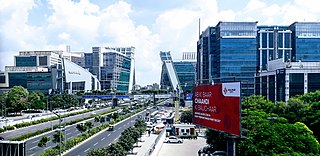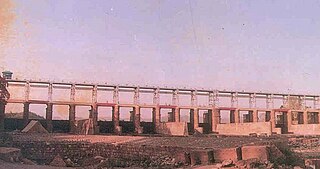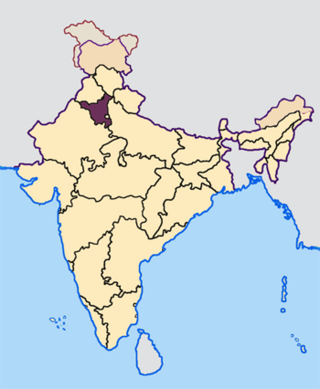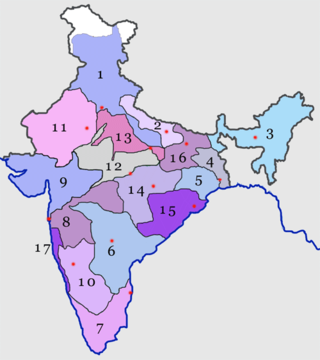Related Research Articles

Haryana is an Indian state located in the northern part of the country. It was carved out of the former state of East Punjab on 1 November 1966 on a linguistic basis. It is ranked 21st in terms of area, with less than 1.4% of India's land area. The state capital is Chandigarh, which it shares with the neighbouring state of Punjab; and the most populous city is Faridabad, which is a part of the National Capital Region. The city of Gurgaon is among India's largest financial and technology hubs. Haryana has 6 administrative divisions, 22 districts, 72 sub-divisions, 93 revenue tehsils, 50 sub-tehsils, 140 community development blocks, 154 cities and towns, 7,356 villages, and 6,222 villages panchayats.

The Yamuna is the second-largest tributary river of the Ganges by discharge and the longest tributary in India. Originating from the Yamunotri Glacier at a height of about 4,500 m (14,800 ft) on the southwestern slopes of Bandarpunch peaks of the Lower Himalaya in Uttarakhand, it travels 1,376 kilometres (855 mi) and has a drainage system of 366,223 square kilometres (141,399 sq mi), 40.2% of the entire Ganges Basin. It merges with the Ganges at Triveni Sangam, Prayagraj, which is a site of the Kumbh Mela, a Hindu festival held every 12 years.

The Chautang is a seasonal river, originating in the Sivalik Hills, in the Indian state of Haryana. The Chautang River is a tributary of the Sarsuti river which in turn is a tributary of the Ghaggar river.

Hisar district is one of the 22 districts of Haryana, India. Hisar city serves as the district headquarters. Hisar district has four sub-divisions that is, Hisar, Barwala, Hansi and Narnaud, each headed by an SDM. The district is also part of Hisar division. Hisar was founded by Firuz Shah Tughlaq.

The Indira Gandhi Canal is the longest canal in India. It starts at the Harike Barrage near Harike, a few kilometers downriver from the confluence of the Satluj and Beas rivers in Punjab state, and ends in irrigation facilities in the Thar Desert in the northwest of Rajasthan state. Previously known as the Rajasthan Canal, it was renamed the Indira Gandhi Canal on 2 November 1984 following the assassination of Prime Minister Indira Gandhi.

Tajewala Barrage is a now decommissioned but existing old barrage across the Yamuna River, located in Yamuna Nagar District, in the state of Haryana, India. Completed in 1873, it regulated the flow of the Yamuna for irrigation in Uttar Pradesh and Haryana through two canals originating at this place namely Western Yamuna Canal and Eastern Yamuna Canal, as well as the municipal water supply to Delhi.
Hathni Kund is a location of origin of Western Yamuna Canal in the Indian state of Haryana, built on a raised plinth overlooking the Yamuna River. The river flows into the plains of Haryana after crossing over the last lap of the Himalayan foothills at Paonta Sahib. The waters of the western Yamuna Canal were collected in the Tajewala Barrage, 5 kilometres (3.1 mi) from Hathni Kund, but this function is now provided by the newer Hathni Kund Barrage.

Haryana is a state in India. The state houses several sites from the Indus Valley Civilization, which was a cradle of civilization. In the Mahabharata, Haryana is mentioned as Bahudanayak Region.

Haryana, formed on 1 November 1966, is a state in North India. For the administrative purpose, Haryana is divided into 6 revenue divisions which are further divided into 22 districts. For Law and Order maintenance, it is divided into 5 Police Ranges and 4 Police Commissionerates.

Kanwari, also spelled Kunwari, or Kwari, is a village of 7,000 population, in Hansi-I Tehsil, Hisar-1 Rural Development Block, Hansi and Hisar of Hisar District of Hisar Division in the Haryana state of India. It is part of the saat bas bhaichara grouping of 7 villages. The village has 4 panna/patti (subdivisions), named as Nangalia Panna , upparla Panna , parla Panna , etc. with a total revenue land area of 43903 kanal or 5487 acre as per HALRIS records.

The following outline is provided as an overview of and topical guide to Haryana.
Muzadpur, also spelled Mujadpur is a village in Hisar, Haryana, India.
Tourism in Haryana relates to tourism in the state of Haryana, India. There are 21 tourism hubs created by Haryana Tourism Corporation (HTC), which are located in Ambala, Bhiwani Faridabad, Fatehabad, Gurgaon, Hisar, Jhajjar, Jind, Kaithal, Karnal, Kurukshetra, Panchkula, Sirsa, Sonipat, Panipat, Rewari, Rohtak, Yamunanagar, Palwal and Mahendergarh.
The Munak Canal is a 102 kilometer long aqueduct that is part of Western Yamuna Canal in Haryana and Delhi states in India. The canal conveys water from the Yamuna River at Munak regulator in Karnal district of Haryana and travels in a southerly direction via Khubru barrage and Mandora barrage, terminating at Haidarpur in Delhi. It is one of the primary sources of drinking water for Delhi. A memorandum of understanding was signed between the Haryana and Delhi governments in 1996 and the Canal was constructed by Haryana between 2003 and 2012 on payment by Delhi. Originally a porous trench, the canal was eventually cemented due to excess seepage, saving 80 million gallons of water per day.
Pathrala Barrage is a barrage across the Somb river, located in Yamuna Nagar District, in the state of Haryana, India.
Dhatrath is a village in Safidon, Jind district at Haryana, India. It belongs to Hisar Division. It is located 16 km from Jind and about 180 km from state capital Chandigarh. Pin code is 126110. Dhatrath is a very old village and also known as Seharda.
The Palla barrage is a barrage located in Palla on the Yamuna-Faridabad canal in Faridabad district of Haryana state in India. This irrigation canal runs to the west of Yaumna through Fridabad, Palwal, Mathura and Agra districts where it terminates in the farms. Palla, Faridabad is not to be confused with Palla, Delhi, a Yamuna pollution monitoring station 23 km upstream of Wazirabad barrage.

The Gokul barrage, also Mathura barrage is a barrage on Yamuna River at Gokul in Mathura district, top of which also serves as the road bridge.

The rail network in the state of Haryana in India, is covered by five rail divisions under three rail zones: North Western Railway zone, Northern Railway zone and North Central Railway zone.
Munak and adjacent Kheri Munak is a village and development block in Assandh sub-district of Karnal district, Haryana, India. Munak canal, which diverts Western Yamuna Canal's water to New Delhi, originates here at Munak regulator.
References
- 1 2 3 GR Blane obituary
- 1 2 3 4 5 6 7 8 9 10 11 12 13 14 Western yaumna Canal Project
- ↑ Hoiberg, Dale (2000). Students' Britannica India, Volumes 1-5. Popular Prakashan. pp. 290–291. ISBN 0-85229-760-2.
- 1 2 India Water Portal
- 1 2 3 4 5 6 7 8 9 10 Delhibird.com
- ↑ Joshi, Mallica; Halder, Ritam (18 June 2015). "Canal that quenches Delhi's thirst" (PDF). Hindustan Times. Retrieved 22 February 2016.
- ↑ Lalchandani, Neha (8 January 2015). "Delhi Jal Board to ready Munak Canal link in 2 months". The Times Of India. No. Delhi. TNN. Retrieved 22 February 2016.
- 1 2 Hindustan Times on Munak Canal
- 1 2 3 Planning Commission of India: Western Yaumna Canal
- 1 2 Jind district profile
- ↑ C.A.H. Townsend, Final report of thirds revised revenue settlement of Hisar district from 1905-1910, Gazetteer of Department of Revenue and Disaster Management, Haryana, point 29.
- ↑ ASI Report on Rakghigrahi excavation
- ↑ C.A.H. Townsend, Final report of thirds revised revenue settlement of Hisar district from 1905-1910, Gazetteer of Department of Revenue and Disaster Management, Haryana, point 25.
- 1 2 JLN CanalLift Irrigation project
- ↑ Masani barrage to be a tourist attraction, The Tribune, Sept 2018.
- 1 2 Archived 7 February 2009 at the Wayback Machine
- 1 2 Setluj-Yamuna link canal obstacles